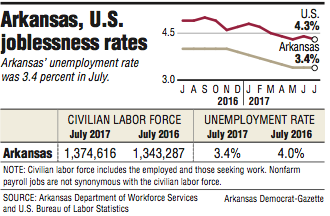Arkansas' unemployment rate was unchanged at 3.4 percent in July compared with June, the U.S. Bureau of Labor Statistics said Friday.
Arkansas' rate has been at 3.4 percent for three straight months, the lowest level ever.
"It's encouraging to see a record low unemployment rate persist," said Mervin Jebaraj, interim director of the Center for Business and Economic Research at the University of Arkansas, Fayetteville.
The national unemployment rate was 4.3 percent in July, down 0.1 percentage point from 4.4 percent in June.
The rates in 46 states were the same in July as in June. Rates dropped in only one state, from 2.3 percent to 2.2 percent in North Dakota, the bureau said.
There were 1,328,119 Arkansans employed last month, an increase of 9,058 since June and up 39,229 since July last year. The civilian labor force, which includes the employed and those looking for work, rose to 1,374,616.
Arkansas' report was "positive along every dimension," said Michael Pakko, chief economist at the Arkansas Economic Development Institute at the University of Arkansas at Little Rock.
"The strong increase in employment is certainly good news," Pakko said. "And the unemployment rate remaining at a very low 3.4 percent is positive news in and of itself."
He is still wary of the data, which will go through an annual revision in March, where more complete data is used than is used throughout the year, Pakko said.
The payroll jobs and the labor force are calculated from two different monthly surveys.
Arkansas' labor force and unemployment rate are calculated through a survey of about 800 households in the state. Nonfarm payroll jobs are determined from a more comprehensive poll of thousands of Arkansas employers who are asked about the size of their workforce.
"Even if the household survey is overstating the gains in employment, I think it is pretty clear from looking at the data in its entirety that we have very strong employment growth going on this year," Pakko said.
The surge Arkansas is seeing in employment is coming from the growth in the labor force participation rate, Pakko said.
Arkansas' labor force participation rate -- the percentage of the population from ages 16 to 64 that is working or seeking work -- has improved by a significant amount this year, Pakko said.
It has risen 1.7 percentage points, from 55.4 percent in January to 57.1 percent in July, Pakko said.
The state's unemployment rate has improved more than expected this year.
Last fall at an annual forecast conference, Pakko projected that Arkansas' unemployment rate would remain in the 4.5 percent to 5 percent range.
Compared with the rest of the country, Arkansas had the second largest annual percentage gain in nonfarm payroll employment, up 2.7 percent in July compared with July last year, according to the federal agency. Only Oregon with a 2.9 percent increase had a bigger gain, the bureau said.
Arkansas added 32,900 nonfarm jobs from July last year to last month.
Eight industry sectors in the state added jobs in July and three declined compared with July last year.
Five of the sectors had annual increases of more than 3,700 jobs.
"This is a continuation of some of the trends we've seen over the past year," Jebaraj said. "The growth is in a good portion of the sectors you like to see."
The biggest annual gain was in the educational and health services sector with 8,200 more jobs in July than in July last year. The leisure and hospitality sector added 7,100 jobs from July to July.
The professional and business services sector grew by 6,700 jobs.
"That, to me, is a sector that the state has been struggling to grow," Jebaraj said.
From July to July, jobs in professional and business services grew by 4.8 percent.
"We've not seen percentages that high in a while," Jebaraj said.
That sector includes doctors, accountants, engineers and architects, Jebaraj said.
The trade, transportation and utilities sector continues to lead Arkansas payroll employment, said Greg Kaza, executive director of the Arkansas Policy Foundation in Little Rock. Trade, transportation and utilities added 5,400 jobs in 12 months, a gain of 2.1 percent.
Manufacturing added 3,700 jobs since July 2016.
Government lost 1,100 jobs since July last year, with the declines coming in state and local government.
North Dakota had the lowest unemployment rate in the country at 2.2 percent, followed by Colorado at 2.4 percent, Hawaii at 2.7 percent and Nebraska and New Hampshire at 2.8 percent each.
Alaska had the highest rate at 7.0 percent, followed by New Mexico at 6.3 percent, Kentucky and Louisiana at 5.3 percent each, and Mississippi and Ohio, which were at 5.2 percent each.
Business on 08/19/2017
